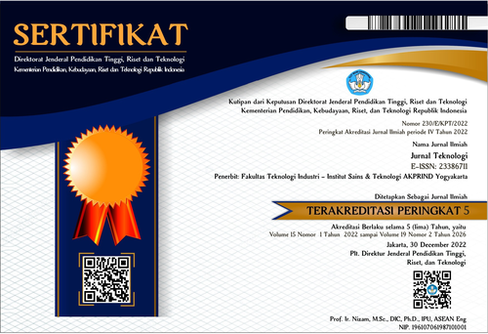Perancangan Alat Otomatisasi Sistem Monitoring Dan Kontroling Tinggi Permukaan Air Sungai Sebagai Peringatan Dini Terjadinya Banjir
DOI:
https://doi.org/10.34151/jurtek.v15i1.3730Keywords:
16x2 LCD, Arduino Uno, Buzzer, LED, SRF 05Abstract
The frequent occurrence of floods caused by overflows of river water indicates a lack of supervision of water level activities, even though the impact of the flood is very detrimental to the community. Therefore we need a business that can monitor and control water capacity, one form of business that can be made is by designing a device that can monitor and control the water level using sensors and microcontrollers. The way this tool works is as a means of detecting water level distances using an SRF 05 sensor by sending a signal to the Arduino uno microcontroller to process the data and then output from the LCD in the form of letters and numbers, the LED indicator which indicates the water level is a warning sign for this system. This system has three levels of water activity levels, namely at level 1 marked with a green LED then at level 2 marked with a blue LED then at level 3 marked with a red LED, the LED connected to the buzzer will provide a warning sign in the form of a siren/alarm that the water has been at the highest level and the relay has come alive with a red color. The design of an automated monitoring and control system for water level using sensors and microcontrollers has been successfully carried out. The purpose of this research is to design a tool that can monitor the water level in real time and is also based on a microcontroller. The calibration results show that the SRF 05 sensor has an average water level measuring instrument accuracy of 99.67% and has an average relative error of 0.33%. The results of this study indicate that the design of the tool that has been made has worked well as a monitoring and control system for water level using the Arduino Uno microcontroller.
Downloads
References
BNPB. (2022). Peringatan Dini Bencana. Retrieved from https://bnpb.go.id/peringatan-dini-bencana
Fairuzelsaid. (2021). Teknik Observasi. Retrieved from https://fairuzelsaid.upy.ac.id/mpti/teknik-observasi/
Filavati, Z. S., & Istarno. (2018). Pemodelan Daerah Risiko Banjir Akibat Luapan Sungai Menggunakan Data Airborne Lidar (Studi Kasus : Sungai Boyong, Daerah Istimewa Yogyakarta). Etd.Repository.Ugm.Ac.Id. Retrieved from http://etd.repository.ugm.ac.id/penelitian/detail/162135
Jaya, H. (2016). Desain Dan Implementasi Sistem Robotika (Pertama, Vol. 300). Makassar: Edukasi Mitra Grafika.
Nasution, R. F. (2019). Sistem monitoring permukaan dan debit air sungai serta intensitas curah hujan sebagai peringatan dini banjir berbasis mikrokontroler atmega32. repository.uinsu.ac.id. Fakultas Sains Dan Teknologi Universitas Islam Negeri Sumatera Utara Medan. Retrieved from http://repository.uinsu.ac.id/9175/1/RIZKI Fitriana Nasution.pdf
Puspasari, F.-, Fahrurrozi, I.-, Satya, T. P., Setyawan, G.-, Al Fauzan, M. R., & Admoko, E. M. D. (2019). Sensor Ultrasonik HCSR04 Berbasis Arduino Due Untuk Sistem Monitoring Ketinggian. Jurnal Fisika Dan Aplikasinya, 15(2), 36. https://doi.org/10.12962/j24604682.v15i2.4393
Rahmaniah. (2021). Analisis Penyebab Bencana Alam Banjir yang Ada di Wilayah Indonesia. Retrieved from http://dx.doi.org/10.31219/osf.io/gmpn4
Sari, M. (2020). NATURAL SCIENCE : Jurnal Penelitian Bidang IPA dan Pendidikan IPA , ISSN : 2715-470X ( Online ), 2477 – 6181 ( Cetak ) Penelitian Kepustakaan ( Library Research ) dalam Penelitian Pendidikan IPA, 6(1), 41–53.
Wibisono, W., & Baskoro, F. (2002). Pengujian Perangkat Lunak Dengan Menggunakan Model Behaviour Uml. JUTI: Jurnal Ilmiah Teknologi Informasi, 1(1), 43. https://doi.org/10.12962/j24068535.v1i1.a95
Downloads
Published
How to Cite
Issue
Section
License
Copyright (c) 2022 Suparman

This work is licensed under a Creative Commons Attribution 4.0 International License.
Jurnal Teknologi provides immediate open access to its content in order of making research freely available to the public to support a global exchange of knowledge. All articles published in this journal are free for everyone to read and download, under licence CC BY SA.
Benefits of open access for the author, include:
- Free access for all users worldwide.
- Authors retain copyright to their work.
- Increased visibility and readership.
- No spatial constraints.




















